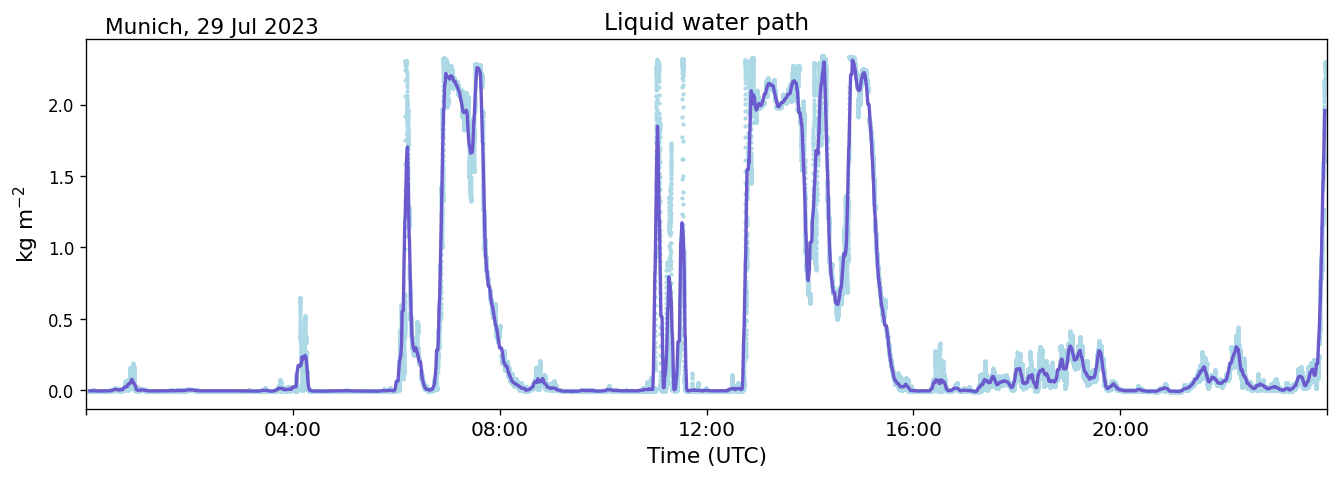Quickstart
In this tutorial products are created from raw data using CloudnetPy’s high level API.
Raw data conversion
Before we can generate Cloudnet products, we need to convert raw instrument data to Cloudnet Level 1b netCDF files. Let’s start with the following raw files from Munich site:
METEK MIRA cloud radar: 20230729_0000.mmclx.gz (decompress before use)
Lufft CHM 15k ceilometer: CHM15kxLMU_20230729.nc
RPG HATPRO microwave radiometer: 230729.LWP
ECMWF model: 20230729_munich_ecmwf.nc
On Linux and macOS these files can be downloaded using the following commands:
curl -O https://cloudnet.fmi.fi/api/download/raw/62905a7c-4e18-474f-8532-bb59f39ca4ff/20230729_0000.mmclx.gz
gunzip 20230729_0000.mmclx.gz
curl -O https://cloudnet.fmi.fi/api/download/raw/7d1909f3-c73f-4de9-a771-e6795751e495/CHM15kxLMU_20230729.nc
curl -O https://cloudnet.fmi.fi/api/download/raw/490704b2-7533-4137-979b-f197a6c72e17/230729.LWP
curl -O https://cloudnet.fmi.fi/api/download/product/856b5a84-155b-427d-b914-09238c206c02/20230729_munich_ecmwf.nc
More raw files can be found using Cloudnet data portal API.
Radar processing
In the first example we convert a raw METEK MIRA-36 cloud radar file into Cloudnet netCDF file that can be used in further processing steps.
from cloudnetpy.instruments import mira2nc
uuid = mira2nc('20230729_0000.mmclx', 'radar.nc', {'name': 'Munich'})
Variable uuid contains an unique identifier for the generated radar.nc file.
For more information, see API reference for this function.
You can plot variables such as radar reflectivity factor from the newly generated file.
from cloudnetpy.plotting import generate_figure
generate_figure('radar.nc', ['Zh'])

Lidar processing
Next we convert a raw Lufft CHM 15k ceilometer (lidar) file into Cloudnet netCDF file and process the signal-to-noise screened backscatter coefficient. Also this converted lidar file will be needed later.
from cloudnetpy.instruments import ceilo2nc
uuid = ceilo2nc('CHM15kxLMU_20230729.nc', 'lidar.nc', {'name': 'Munich', 'altitude': 538})
Variable uuid contains an unique identifier for the generated lidar.nc file.
For more information, see API reference for this function.
You can plot variables such as attenuated backscatter coefficient from the newly generated file.
generate_figure('lidar.nc', ['beta'])

MWR processing
Next we convert RPG-HATPRO microwave radiometer (MWR) binary files (e.g. *.LWP) into Cloudnet netCDF file to retrieve integrated liquid water path (LWP).
from cloudnetpy.instruments import hatpro2nc
uuid, valid_files = hatpro2nc('.', 'mwr.nc', {'name': 'Munich', 'altitude': 538}, date='2023-07-29')
Variable uuid contains an unique identifier for the generated mwr.nc file and valid_files contains which files were used for the processing.
For more information, see API reference for this function.
You can plot variables such as liquid water path from the newly generated file.
generate_figure('mwr.nc', ['lwp'])

Note
Separate MWR instrument is not required if you have a 94 GHz RPG cloud radar. RPG radars contain a single MWR channel providing LWP measurements, which can be used in CloudnetPy. Nevertheless, it is always recommended to equip a measurement site with a dedicated multi-channel radiometer if possible.
Model data
Model files needed in the next processing step can be downloaded from the Cloudnet data portal API. Several models may be available depending on the site and date. The list of different model models can be found here.
You can plot variables such as cloud fraction from the model file.
generate_figure('20230729_munich_ecmwf.nc', ['cloud_fraction'])

Product generation
After processing the raw radar, lidar and MWR files, and acquiring a model file, Cloudnet products can be created.
Categorize processing
In the next example we create a categorize file starting from the
radar.nc, mwr.nc and lidar.nc files generated above. The required
20230729_munich_ecmwf.nc file can be downloaded from the top of this page.
from cloudnetpy.categorize import generate_categorize
input_files = {
'radar': 'radar.nc',
'lidar': 'lidar.nc',
'model': '20230729_munich_ecmwf.nc',
'mwr': 'mwr.nc'
}
uuid = generate_categorize(input_files, 'categorize.nc')
Variable uuid contains an unique identifier for the generated categorize.nc file.
For more information, see API reference for this function.
Note that with a 94 GHz RPG cloud radar, the radar.nc file can be used as input
for both inputs: 'radar' and 'mwr'.
Classification processing
In the last example we create the smallest and simplest Cloudnet product, the classification product. The product-generating functions always use a categorize file as an input.
from cloudnetpy.products import generate_classification
uuid = generate_classification('categorize.nc', 'classification.nc')
Variable uuid contains an unique identifier for the generated classification.nc file.
Corresponding functions are available for other products
(see Product generation).
You can plot variables such as target classification from the newly generated file.
generate_figure('classification.nc', ['target_classification'])
